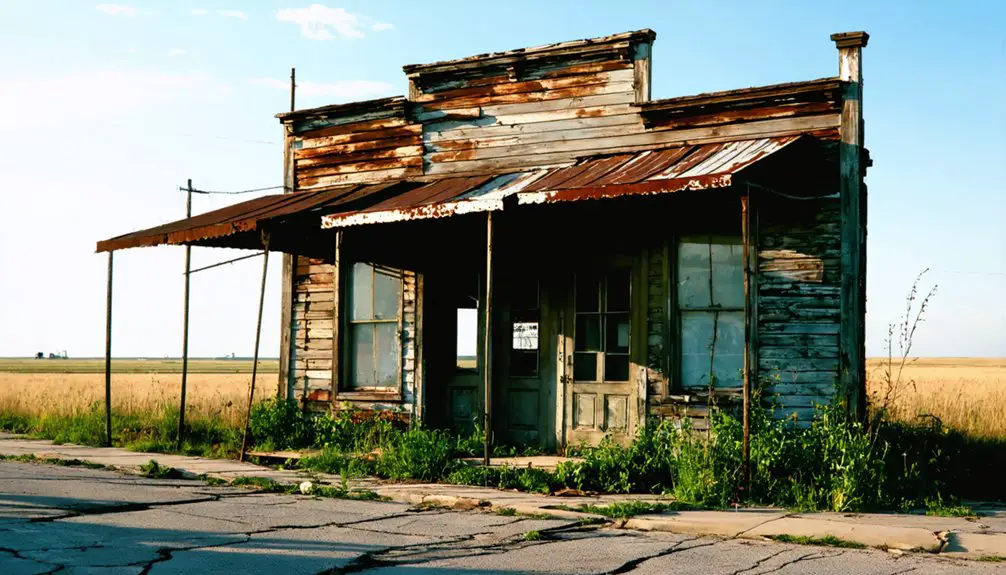You’ll find Armour’s ghost town story in Pawnee County, Nebraska, where it thrived as an agricultural hub until 1934. The town reached 100 residents by 1910, centered around its post office and essential grain elevator. After a devastating 1904 dispute led the railroad to remove the elevator siding, Armour’s fortunes quickly declined. By the 1930s, this once-promising prairie settlement had completely vanished, leaving behind a compelling tale of railroad politics and agricultural ambition.
Key Takeaways
- Armour, Nebraska was a late 19th-century agricultural community that reached its peak population of 100 residents in 1910.
- The town’s decline began in 1904 when a dispute led to the railroad company dismantling the elevator siding, crippling grain shipping.
- By 1918, most residents had abandoned their homes due to economic struggles following the loss of grain transport capabilities.
- The post office, operating from 1890 to 1934, marked Armour’s final functioning institution before complete abandonment.
- The town site now shows no trace of its existence, with land reverting to agricultural use or natural state.
The Rise and Fall of a Prairie Settlement
When settlers established Armour, Nebraska in the late 19th century, the town emerged as a small but promising agricultural community in Pawnee County.
You’ll find the town’s early community dynamics reflected in its Moravian-named streets and vital businesses, including a blacksmith shop, grocery store, and dance hall. Much like Omaha’s early days, the town formed a Claim Club to address property disputes and squatters. The railroad became the lifeline of this prairie settlement, with a significant grain elevator positioning Armour as a local agricultural hub. Like many towns of the era, it relied on a post office system to maintain communication and commerce with neighboring communities.
However, the town’s fate changed dramatically in 1904 when transportation influence took a dark turn.
Like a storm gathering on the horizon, 1904 marked the year when Armour’s promising future derailed into darkness.
After a dispute with the local elevator operator, the railroad company’s decision to dismantle the elevator siding overnight effectively strangled the town’s grain shipping capabilities. This devastating blow led to Armour’s rapid decline, and by 1918, most residents had abandoned their homes.
Life in Early Armour
You’d find the early settlers of Armour organizing their daily activities around the local post office, which served as a crucial communication hub connecting isolated homesteads to the wider world.
Rural mail carriers would brave challenging weather and primitive roads to deliver letters, newspapers, and packages to scattered farmsteads throughout the region.
The agricultural community grew steadily as more families established their homesteads, working together during planting and harvest seasons while sharing equipment and labor to guarantee collective survival on the Nebraska prairie. Many settlers acquired their land through five dollars an acre payments, making the dream of property ownership achievable for farming families. Similar to the pioneers at Rock Creek Station, they built basic cabins that gradually evolved into more substantial homesteads.
Daily Rural Postal Operations
The establishment of Armour’s post office on February 1, 1904, marked a pivotal advancement in rural Nebraska’s postal service through the introduction of Rural Free Delivery (RFD).
As a crucial communication hub, the post office transformed daily life for isolated farming families, connecting you directly to the broader world through mail delivery right to your doorstep.
If you’d lived in Armour then, you’d have witnessed postal carriers maneuvering lengthy postal routes on horseback or in wagons, battling primitive roads and harsh weather to maintain delivery schedules. Some carriers endured journeys spanning up to 700 miles per route to reach just a handful of households.
The carriers didn’t just bring letters – they were your lifeline to markets, news, and essential goods.
While the routes weren’t profitable, they fulfilled a critical universal service obligation, ensuring every rural resident stayed connected despite the operational challenges of serving Nebraska’s sparsely populated countryside.
Agricultural Community Development
As settlers flocked to Nebraska Territory after 1854, Armour emerged as a quintessential farming community shaped by the transformative Homestead Act of 1862. You’d find homesteaders building sturdy brick homes and digging wells, while establishing their required 160 acres through intensive labor and determination.
Community collaboration defined life in early Armour, where you’d see farmers sharing knowledge and labor during critical planting and harvest seasons. Your success depended on balancing diverse crops like corn, wheat, and flax with livestock operations to guarantee agricultural sustainability. The state’s Kansas-Nebraska Act in 1854 set the foundation for agricultural development in communities like Armour, covering vast territories that would become prime farming land.
You’d participate in seasonal rhythms of farm work, from the essential summer quarter’s soil preparation to managing cattle herds that provided both income and draft power. Railroad connections to stockyards meant you could transport your livestock to broader markets, strengthening Armour’s agricultural economy.
The Post Office Years: 1890-1934
During its 44-year operation from 1890 to 1934, Armour’s post office served as an important communication hub for residents and businesses throughout Pawnee County, Nebraska.
Similar to how early armature equipment shaped the development of defensive gear in ancient civilizations, the post office’s significance extended beyond mail delivery, reinforcing community identity and local commerce during the region’s early development. You’ll find this postal station’s legacy deeply woven into Armour’s rise and eventual shift to ghost town status.
Key aspects of Armour’s postal operations included:
- Location coordinates at 40.119445°N, 96.420294°W, establishing a fixed point for mail delivery
- Naming ties to Armour and Company meatpacking firm, reflecting the area’s economic connections
- Postmasters who served as both postal administrators and community leaders, following federal regulations while maintaining local service standards
The office’s closure in 1934 marked the end of Armour’s significance as a populated community.
Agricultural Roots and Economic Influences
You’ll find Armour’s agricultural heritage closely aligned with southeastern Nebraska‘s shift from prairie to cultivated farmland, reflecting the broader patterns seen in places like Brownville where corn and wheat dominated early crop production.
The town’s strategic location positioned it within the region’s growing livestock industry, providing essential services to farming families who increasingly specialized in operational tasks and equipment management. Similar to Brownville’s distinction as the origin point for first railcar of wheat, Armour played a vital role in the region’s grain transportation network.
Armour’s post office served as an important hub for agricultural commerce from 1890 to 1934, facilitating communication and trade that supported the area’s farming economy during a period of significant mechanization and infrastructure development.
Regional Farming Patterns
The establishment of Nebraska Territory in 1854 transformed the region’s agricultural landscape, laying the foundation for what would become one of America’s most productive farming regions.
You’ll find that early settlers faced farming challenges as they worked to establish sustainable crop yields, but the rich soil conditions supported remarkable crop diversification.
Throughout the region, farmers adapted to local conditions by:
- Growing corn as the dominant crop, which you’d find thriving in the fertile valleys
- Cultivating diverse crops like wheat, oats, rye, and flax to maximize land use
- Implementing tobacco farming in select areas where conditions proved favorable
The area’s farming success was bolstered by pioneers like Frank Franklin Johanssen, who established the first wheat checkoff program to generate vital funding for research and education.
Livestock Industry Connections
While Nebraska’s early agricultural focus centered on crop farming, livestock operations soon emerged as a powerful economic force that would transform the region.
You’ll find that Omaha’s strategic location near the Union Pacific Railroad made it an ideal hub for livestock transportation, connecting western ranches to eastern markets.
The introduction of refrigerated rail cars revolutionized meatpacking innovations, allowing packers to ship processed meat instead of live cattle. Armour and Company’s expansion helped make Omaha the largest meatpacking city by 1959.
Post-Office Economic Impact
Established in 1890, Armour’s post office emerged as an essential economic hub that shaped the town’s agricultural development for over four decades.
You’ll find that postal service catalyzed local prosperity by enabling farmers to connect with broader markets and receive crucial agricultural supplies through mail-order services.
The post office’s impact on economic diversification manifested in several key ways:
- Facilitated financial transactions through money orders, strengthening local commerce
- Attracted complementary businesses like general stores near the postal location
- Enabled direct communication with external markets and government agencies for agricultural pricing and innovations
When the post office closed in 1934, it marked a turning point in Armour’s decline, reflecting the changing agricultural landscape and diminishing rural population that had once thrived around this crucial communication center.
Lost to Time: The Town’s Disappearance
Once a thriving outpost in Pawnee County, Armour’s descent into obscurity began with its post office closure in 1934, marking the final chapter of a community that had peaked at 100 residents in 1910.
Today, you’ll find no trace of the town at its original coordinates (40°07′10″N 96°25′13″W), as harsh climate conditions and shifting economic patterns erased all physical remnants of this Nebraska settlement.
The land where Armour once stood has returned to its natural state or agricultural use, with community memories fading as quickly as the town’s structures disappeared.
The agricultural decline that plagued many small Plains communities, combined with changes in transportation routes and the challenging Nebraska climate, sealed Armour’s fate.
Now it exists only in historical records and ghost town listings, a reflection of the impermanence of early frontier settlements.
Legacy in Nebraska’s Ghost Town History

The story of Armour stands as a compelling example in Nebraska’s rich ghost town heritage, particularly due to its direct connection to the meat-packing industry that shaped the region’s development.
As you explore Nebraska’s industrial decline, you’ll find Armour’s transformation from a bustling community to a ghost town reflects broader economic shifts that reshaped the Midwest.
Three key aspects define Armour’s historical significance:
- Its rise and fall mirrors the evolution of refrigeration technology, from ice harvesting to modern cooling.
- The town’s existence depended on a single industry, making it vulnerable to economic changes.
- Its complete disappearance by the mid-1930s represents the fate of many industry-dependent communities.
Today, while no physical structures remain, Armour’s story continues to teach valuable lessons about economic diversification and community resilience.
Frequently Asked Questions
Were There Any Notable Crimes or Mysteries Associated With Armour’s History?
Like searching for a needle in Nebraska’s haystack, you won’t find records of unsolved disappearances or ghostly sightings in Armour’s brief history from 1890-1934 – no notable crimes either.
What Natural Disasters, if Any, Affected the Town of Armour?
You won’t find any documented tornado impacts or flood aftermath affecting this settlement. Historical records don’t show any natural disasters directly contributing to the town’s eventual abandonment in southeastern Nebraska.
Did Any Famous People Ever Visit or Live in Armour?
Like stars that never graced the prairie sky, you won’t find any famous visitors or celebrity sightings in Armour’s history. Historical records show no evidence of notable residents here.
What Native American Tribes Originally Inhabited the Area Before Armour’s Establishment?
You’ll find the Omaha and Ponca tribes were the primary inhabitants of eastern Nebraska’s river regions before white settlement, establishing their territories along the Missouri River during the 1700s.
How Many Residents Lived in Armour During Its Peak Population Years?
Like pioneers spreading across the plains, you’d have found about 100 residents during the peak population years of the 1870s-1880s, marking a time of historical significance for this frontier settlement.
References
- https://history.nebraska.gov/wp-content/uploads/2017/12/doc_publications_NH1937GhostTowns.pdf
- https://kids.kiddle.co/Armour
- https://en.wikipedia.org/wiki/Armour
- https://www.wikiwand.com/en/articles/Armour
- https://www.ghosttowns.com/states/ne/armour.html
- https://www.youtube.com/watch?v=RODvVi84tLk
- https://en.wikipedia.org/wiki/History_of_Omaha
- https://nebraskarules.tripod.com/id11.html
- https://nebraskacityne.gov/history-of-nebraska-city/
- https://www.upperbigblue.org/sites/default/files/resource-files/old-settlers-early-history-york-co.pdf



